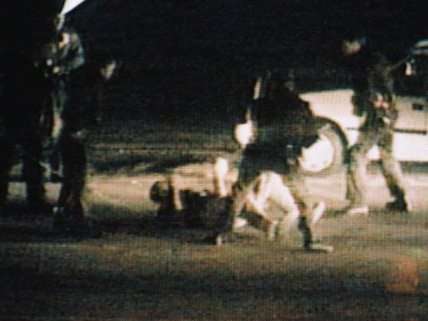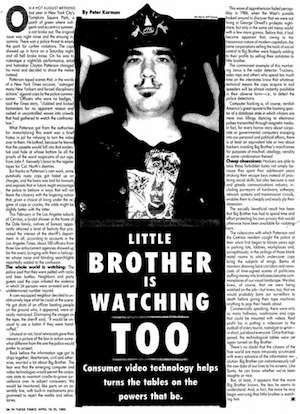Friday A/V Club: Before Rodney King
Turning the surveillance state upside down

We live in a time of two-way surveillance. On one hand, governments and other powerful institutions can track us more closely than ever before. On the other hand, ordinary civilians can pull out a cell phone and start recording if they see a cop or some other official doing something abusive, irresponsible, or just embarrassing.
We all know that. But there was a time when hardly anyone saw such a future coming. Four decades ago, it was widely assumed that new surveillance technologies would serve only the state and the corporate world. The idea that ordinary people might point a lens back at the powerful didn't really take hold until a witness with a camcorder recorded the beating of Rodney King in 1991.
Yet that wasn't the first time a man with a camera was at the right place to tape some cops who'd gotten out of control. If you were attentive enough, you could see the outlines of the new era taking shape even before King came along. Two years earlier, for example, in Cerritos, California,
a bridal shower at the home of the Dole family, natives of Samoa, apparently attained a level of festivity that provoked the interest of the sheriff's department. In all, according to accounts in the Los Angeles Times, about 100 officers from three law enforcement agencies showed up for the event, bringing with them a helicopter whose noise and blinding searchlights reportedly added to the confusion.
The police said that they were pelted with rocks and beer bottles. Neighbors and party guests said the cops initiated the violence in which 34 persons were arrested and an undetermined number injured.
A cam-equipped neighbor decided to unobtrusively tape what he could of the scene. He got shots of an officer beating people on the ground who, it appeared, were already restrained. Dismissing the images on the tape, the sheriff said, "It would be unusual to use a baton if they were handcuffed."
Unusual or not, local newscasts gave their viewers a picture of the law in action somewhat different from the one the police would prefer to project.
The story ultimately ended with what the Los Angeles Times called "the largest civil rights damage award against police in California history." Here's a news report that includes some of the neighbor's footage, starting about 48 seconds in:
And that tape wasn't the first either. A year before police attacked the Doles' home, two men carrying cameras—Clayton Patterson and Paul Garrin—happened to be on the scene during the Tompkins Square Park Riot of 1988, when squatters and cops clashed over control of a park in Manhattan. When officers started clubbing bystanders and otherwise trampling people's rights, there was videotape to back up the victims' complaints. In one meta moment, Patterson got footage of the police smashing Garrin into the wall.
There may well be even earlier examples. But it's the events in Cerritos and in Tompkins Square Park that were cited in a prescient piece Peter Karman wrote for the leftist paper In These Times. (That's where that passage I quoted about the Dole party came from.) The article was titled "Little Brother Is Watching Too"—in those days, that headline wasn't a cliché yet—and it appeared in 1989, long before the world had heard the name Rodney King.
Citing a variety of examples—not just camcorders but radar detectors and the tools used by hackers—Karman argued that the surveillance state was being turned upside down. He also noted the central role that market forces were playing in this transformation, though he phrased this in a way calibrated to appeal to In These Times' socialist audience: "owing to the treasonous nature of modern capitalism," he wrote, "the same corporations selling the tools of social control to Big Brother were happily adding to their profits by selling their antidotes to little brother."
Later in the article, he extended the point:

The videocams with which Patterson and the Cerritos resident caught the police at their worst first began to bloom years ago in parking lots, lobbies, workplaces and, surreptitiously, in the ceilings of those blank motel rooms to which undercover cops bring the subjects of stings. Banks of monitors showing bare corridors and newscasts of time-signed scenes of politicians stuffing money into briefcases became commonplaces of our visual landscape. We also knew, of course, that we were being watched on the job—but knew, too, that we would probably bore our surveyors to death before giving their tape machines anything to pop their heads about.
Commercially speaking, there were only so many hallways, washrooms and cops that could be mounted with videos. Real profit lay in putting a videocam to the eyeball of every tourist, nostalgist or artist—in short, just about everyone. Once that happened, the technological tables again turned on Big Brother.
Today millions of Americans carry pocket-sized devices that can not just record the police but transmit their footage to the world. In the future, those tools will be even smaller and more ubiquitous. (If Google Glass–style technologies catch on with the wider public, Karman's line about "putting a videocam to the eyeball" may prove even more prophetic than it looks now.) And just about everyone understands this. What was a counterintuitive thesis in 1989 is now the conventional wisdom. It's reached the point where some anti-authoritarians have had to start issuing reminders that these technologies can still be used by powerful people too.
But there was a time when most people didn't realize that anyone but the powerful could deploy this tech. Kudos to Karman for seeing so early that the future would be more complicated than that.
(For some of Patterson's footage from the Tompkins Square Riot, go here. For some of Garrin's footage, go here. For past editions of the Friday A/V Club, go here.)
Editor's Note: As of February 29, 2024, commenting privileges on reason.com posts are limited to Reason Plus subscribers. Past commenters are grandfathered in for a temporary period. Subscribe here to preserve your ability to comment. Your Reason Plus subscription also gives you an ad-free version of reason.com, along with full access to the digital edition and archives of Reason magazine. We request that comments be civil and on-topic. We do not moderate or assume any responsibility for comments, which are owned by the readers who post them. Comments do not represent the views of reason.com or Reason Foundation. We reserve the right to delete any comment and ban commenters for any reason at any time. Comments may only be edited within 5 minutes of posting. Report abuses.
Please to post comments



So? socialists regard it as treasonous for companies to sell recording equipment to the people so they can turn it on the state? 😀
Hey man, it was the '80s.
"We live in an time..."
Seriously?!? Typo in the first four words?
he was an hero
Once upon an time he was an hero.
Now, after the operation, she are an heroine fighting the Lords of the Cis.
'e were an 'ero /cockney
Those cops are lucky to be alive. Samoans can be pretty bad motherfuckers and family is very important to them.
And they have their own Swat Team.
Samoans With Attitude Troubles
"Man, those Samoans are a surly bunch."
Darryl F. Gates, Police Quest!
How many of those cops went to prison?
Now tell me again how recording them matters.
If you survive the encounter, you might get a payout?
20 millions a rounding error to them. 200 million would get there attention.
Apparently not.
These early videos are just the first rungs on the ladder of changing the public's attitude about Officer Friendly.
I buy almost everything except food and clothing from online auctions most people aren't aware of the almost I unbelievable deals that they can get from online auction sites the site that has the best deals is.....
BEST HOME BASE GIFT-------- http://snipr.com/29inp5v
Which is why it's more important than ever to whither the state.
Dog bites man is not news, man bites dog IS news.
Unless man bites dog 3 times a day every day, then it stops being news.
A Samoan Bridal Shower sounds like a heck of a cocktail.
Have you seen the complete Rodney King video? The media neglected to include the first part where King attacked the cops.
The one and only place I ever saw the FULL video was on Rush Limbaugh's TV show. ABC, CBS, NBC and CNN showed only the part of the video of the cops' response to King's attack.
I bet the jury saw the full video and that's why they acquitted the police. The video showed a clear case of self defense against a man hopped up on something that made him practically immune to a Taser.
The media did the same thing in the Trayvon Martin case with editing the 911 call and they tried it again in Ferguson.
The WWW has become a tool to get the full truth out despite the leftist media shaping public opinion by editing to make things appear to be opposite to what they really are.